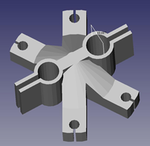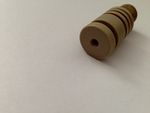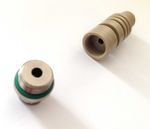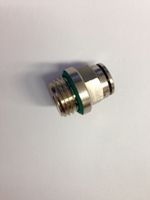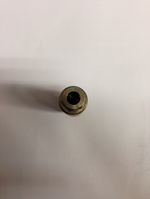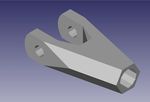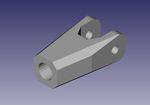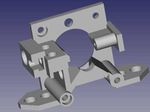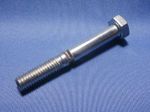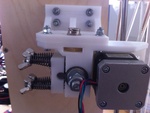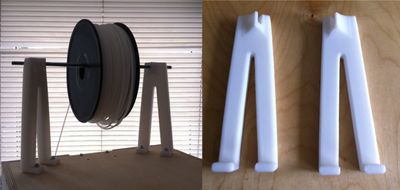Category:Mendel Rostock Development
Besides the re-design of existing there was the design of new components for Mendel Rostock (modified in Jena electronic things). We present you with this 3D printer an optimized system and show you in this article the improvements and modifications compared with the previous model.
Framework
The first improvement idea of the system dealt with the printer stand. To prevent warping of the frame, the bottom, top and side panels were created massive. The thickness of the bottom and cover plate of 12 mm was extended to 15 mm. As sidewalls 12 mm were selected strong plates. A second supporting sidewall and internal angle in the housing should provide additional stability. The side walls serve not only to stiffen the system but also the attachment of subsequent components such as. Electronics. The 'Picture 1' , the modified printer housing be removed from the back view.
Endeffctor
The end effector comprises penholder, platform and Hotend. The penholder is the holder for the Hotend in which the filament is heated and from which it is extruded. Originally the penholder for Hotend's designed with an outer diameter of 10 mm (see 'Figure 2' ).
Since the thermal barrier of our Hotend's has a diameter of 16 mm, the redesign of the penholders was necessary. The new penholder was designed so that the old platform (see 'Figure 3' ) for attachment of penholder and printer arms could be used.
This had to be redesigned only one component. The new penholder (see 'Figure 4' ) consists of a simple plate with a hole the size of 16 mm for the Hotend. In addition, the Hotend is fixated by two horizontal screws inserted.
On 'Figure 5' is to see the standard Peek barrier.
In 'Figure 6' modified for Rostock Peek barrier is ready. The standard barrier was slightly prolonged, in order to introduce on the top of a thread.
Here a metallic hose coupling is screwed (see 'Figure 7' & '8' ).
In 'Figure 9' is to see the ready-assembled end-effector.
Carriages
As the cars Carriages carriages are called, which are located on the LM8UU camps on the silver steel shafts. Originally, they are driven by a closed belt GT. 2 We use T2.5 endless belt. Consequently, we had to use other pulleys and the carriage design larger, in order to fix both ends of the belt. Decisive for the redesign, however, the idea was to provide an opportunity to in the event of extension of the belt, to tighten them. In this way, the attachment always new timing belt is to be avoided. For this purpose an attachment is at the protruding end thereof, which contains the toothing of the belt as notches (see 'Figure 10' ).
Jaws
Jaws are the ends of the arms printer, are connected to one another via the arms, and end effector Carriages. These were modified and made thicker. 'Figure 11' formed from the original version.
On 'Figure 12' the modified and so more powerful version is shown.
This type of Jaws, we need, as we have decided to dispense with a purely printed printer arms and to produce aluminum rods.
Extruder
The feed unit of the extruder through which the filament is guided into the Hotend had to be redesigned. In 'Figure 13' of the initial extruder is mapped
After several extrusion tests with original Rostock extruder, we found this not considered mature. For this reason we decided to change this. We modified an original Wade extruder and brought a recess in the side for Hotend out a. Here a mother is positioned, in turn, a metallic "hose coupling" is screwed. 'Figure 14' illustrates the modified Wade extruder.
The choice of another Filamentschraube, is an innovation compared with the original. On 'Figure 15' the Filamentschraube demonstrates that we use for the Mendel Rostock.
It is the standard Filamentschraube that we mount extruder in Wade and Greg Wade. On 'Figure 16' of the modified and already built Wade extruder is ready.
roll mounting
To place the Filamentrolle space as possible, the holder was mounted on top of the printer. In order to distribute the weight of non-critical, the attachment was carried out as far as possible at the edges, where the plywood the printer additionally stabilize ( 'Figure 17' ).
If you have questions about the structure or the printer function manner in detail, please contact us via 'Email' to '[email protected]' or simply 'Telephone' ' ':' +49 (0) 3641 50 96 06 '. The 'modified RP-parts 'for' Mendel Rostock 'are in 'Thingiverse' as' stl files' uploaded. The 'complete kit of parts for Mendel Rostock' is in our 'Shop' available.
Pages in category "Mendel Rostock Development"
This category contains only the following page.

